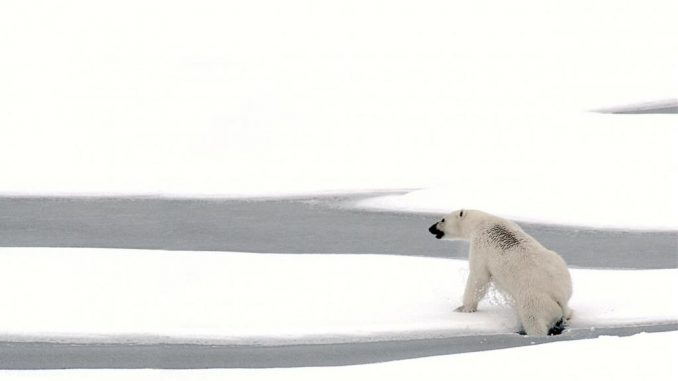
Kyoto University and UCSD uncover a cause for the warming in the Arctic in the early 20th century. CREDIT Kyoto University
From the universities of Kyoto & San Diego comes this old tired catchphrase, along with a polar bear picture to go with the press release.
Is a warmer Arctic a canary of global warming?
Since the 1970s the northern polar region has warmed faster than global averages by a factor or two or more, in a process of ‘Arctic amplification’ which is linked to a drastic reduction in sea ice.
But then how to explain a similar rapid warming that occurred during the early 20th century, when the effects of greenhouse gases were considerably weaker than today? And what can we prove about the period, given the scarcity of usable data and observations prior to the 1950s?
Now scientists from Kyoto University and UC San Diego have discovered that this phenomenon occurred when the warming phase — ‘interdecadal variability mode’ — of both the Pacific and Atlantic Oceans coincided. The team’s findings appeared recently in the journal PNAS.
“We found that early 20th century sea surface temperatures in the tropical Pacific and North Atlantic had warmed much more than previously thought,” explains lead author Hiroki Tokinaga of Kyoto.
“Using observations and model simulations, we’ve demonstrated that rising Pacific-Atlantic temperatures were the major driver of rapid Arctic warming in the early 20th century.”
Previous explanations for early Arctic warming have including decreased volcanic aerosols and increased solar radiation, but none of these have been able to simulate observed conditions from the period.
Tokinaga’s team found that when the interdecadal rise in sea surface temperatures was included in simulation calculations, the results properly reflected early Arctic conditions.
“Coupled ocean-atmosphere simulations also support the intensification of Arctic warming,” continues Shang-Ping Xie of UCSD, “which was caused by a concurrent, cold-to-warm phase shift of Pacific and Atlantic interdecadal modes.”
The researchers explain that these new findings can help constrain model climate projections over the Arctic region.
“It is likely that temperatures in the Arctic will continue to rise due to anthropogenic global warming,” concludes Tokinaga. “Our study does not deny this. We are rather suggesting that Arctic warming could accelerate or decelerate due to internal variability of the Pacific and the Atlantic.”
“It is a challenge to accurately predict when the next big swing of multidecadal variability will occur. Careful monitoring is essential, given the enormous impact on the Arctic climate.”
###
The paper “Early 20th-century Arctic warming intensified by Pacific and Atlantic multidecadal variability” appeared 30 May 2017 in the Proceedings of the National Academy of Sciences of the United States of America, with doi: 10.1073/pnas.1615880114
Pacific North American circulation pattern links external forcing and North American hydroclimatic change over the past millennium
Significance
We have developed a new reconstruction of changes in the wintertime atmospheric circulation over North America based on data distributed across the region. The record spans almost 1,000 years and shows how variation in ocean temperatures, solar energy, volcanic eruptions, and greenhouse gases has affected circulation over this period. We show that the circulation pattern is strongly correlated with fluctuating drought conditions in the western United States. Climate models do a poor job of simulating the reconstructed record of circulation change, and thus may have difficulty predicting future patterns of drought influenced by changing winter storm tracks across this region.
Abstract
Land and sea surface temperatures, precipitation, and storm tracks in North America and the North Pacific are controlled to a large degree by atmospheric variability associated with the Pacific North American (PNA) pattern. The modern instrumental record indicates a trend toward a positive PNA phase in recent decades, which has led to accelerated warming and snowpack decline in northwestern North America. The brevity of the instrumental record, however, limits our understanding of long-term PNA variability and its directional or cyclic patterns. Here we develop a 937-y-long reconstruction of the winter PNA based on a network of annually resolved tree-ring proxy records across North America. The reconstruction is consistent with previous regional records in suggesting that the recent persistent positive PNA pattern is unprecedented over the past millennium, but documents patterns of decadal-scale variability that contrast with previous reconstructions. Our reconstruction shows that PNA has been strongly and consistently correlated with sea surface temperature variation, solar irradiance, and volcanic forcing over the period of record, and played a significant role in translating these forcings into decadal-to-multidecadal hydroclimate variability over North America. Climate model ensembles show limited power to predict multidecadal variation in PNA over the period of our record, raising questions about their potential to project future hydroclimatic change modulated by this circulation pattern.
The paper is paywalled, so I can’t comment on the merits of it, but a couple of things come to mind from what is presented so far in the press release and abstract.
- Do you really need to use a polar bear photo? Won’t the science stand on it’s own merit without the need for something that tugs at peoples heartstrings?
- By the same token, why push the overused “canary in the coal mine” meme? Same argument.
- If the early 20th century Arctic warming was caused by ” this phenomenon occurred when the warming phase — ‘interdecadal variability mode’ — of both the Pacific and Atlantic Oceans coincided” but in the present you claim “It is likely that temperatures in the Arctic will continue to rise due to anthropogenic global warming,” concludes Tokinaga. “Our study does not deny this. We are rather suggesting that Arctic warming could accelerate or decelerate due to internal variability of the Pacific and the Atlantic.”, is this just throwing a bone to the financing gods? Why couldn’t “‘interdecadal variability mode’ — of both the Pacific and Atlantic Oceans” be the cause now?


